Pecharsky V.K., Zavalij P.Y. Fundamentals of Powder Diffraction and Structural Characterization of Materials
Подождите немного. Документ загружается.

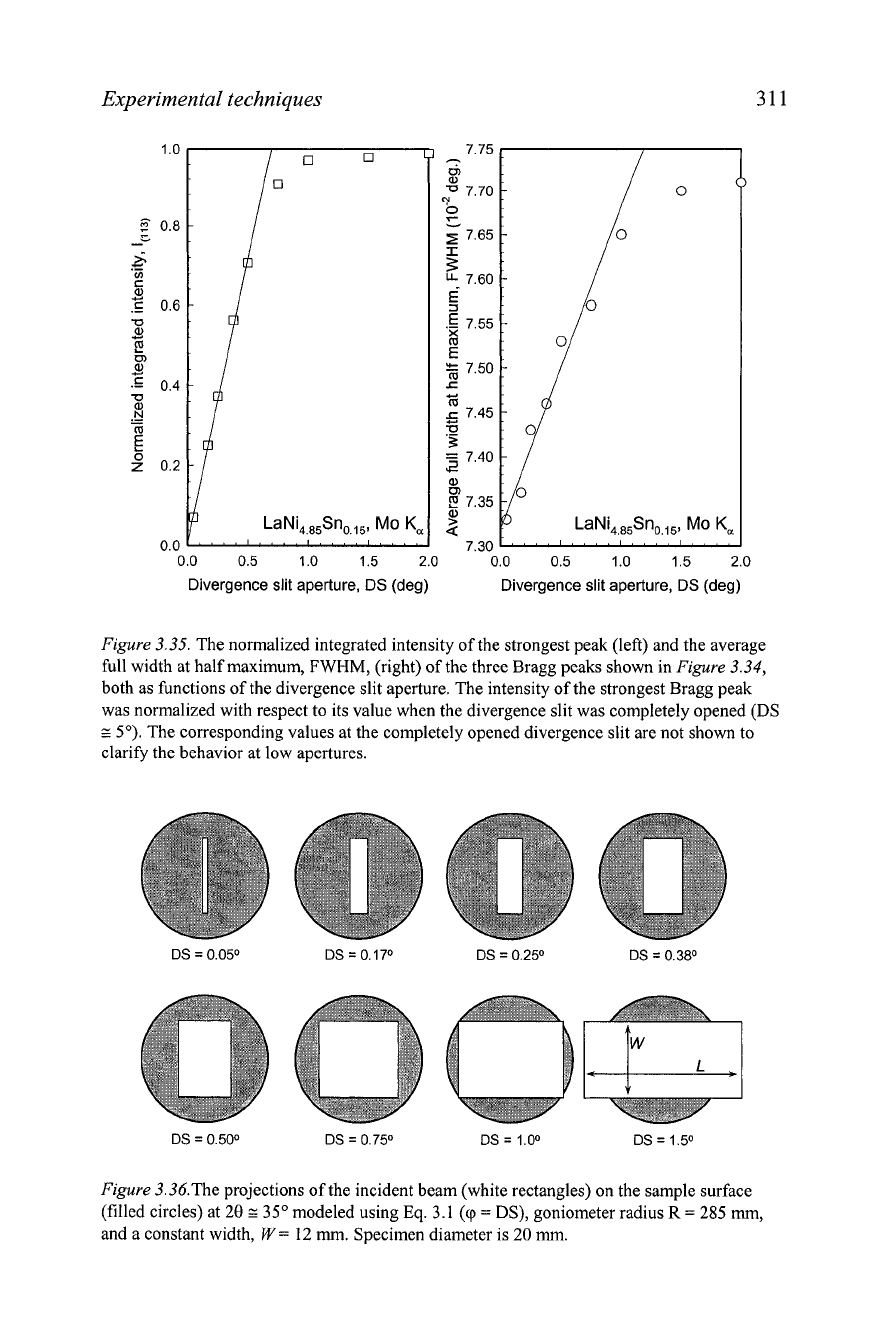
Experimental techniques
0.0 0.5 1.0 1.5 2.0 0.0 0.5 1.0 1.5 2.0
Divergence slit aperture, DS (deg) Divergence slit aperture, DS (deg)
Figure
3.35. The normalized integrated intensity of the strongest peak (left) and the average
full width at half maximum,
FWHM,
(right) of the three Bragg peaks shown in
Figure
3.34,
both as functions of the divergence slit aperture. The intensity of the strongest Bragg peak
was normalized with respect to its value when the divergence slit was completely opened (DS
z
So).
The corresponding values at the completely opened divergence slit are not shown to
clarify the behavior at low apertures.
Figure
3.36.The projections of the incident beam (white rectangles) on the sample surface
(filled circles) at
28
z
35"
modeled using
Eq.
3.1
(9
=
DS),
goniometer radius
R
=
285
mm,
and a constant width,
W=
12
mm.
Specimen diameter is
20
mm.
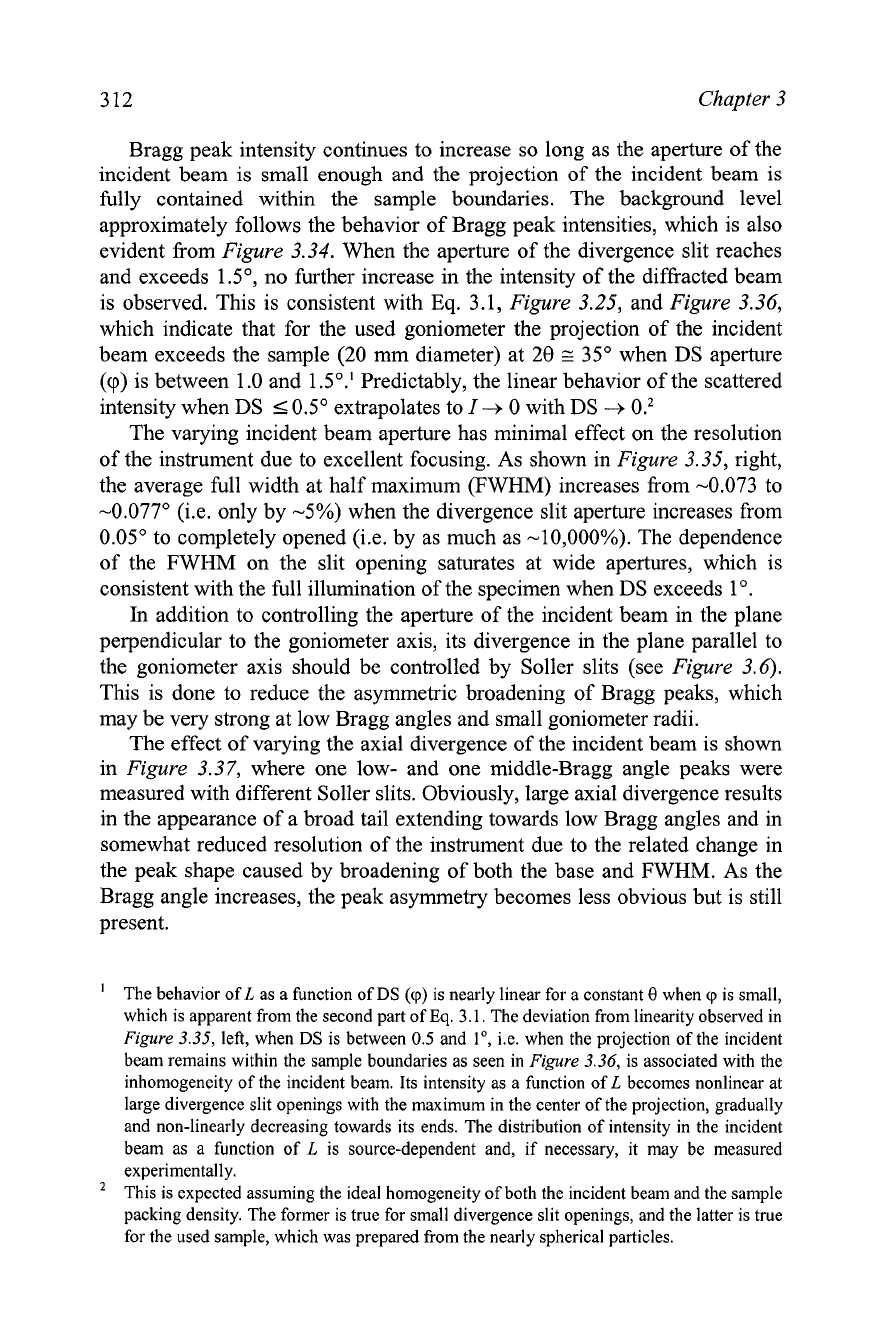
Chapter
3
Bragg peak intensity continues to increase so long as the aperture of the
incident beam is small enough and the projection of the incident beam is
fully contained within the sample boundaries. The background level
approximately follows the behavior of Bragg peak intensities, which is also
evident from
Figure
3.34. When the aperture of the divergence slit reaches
and exceeds 1.5", no further increase in the intensity of the diffracted beam
is observed. This is consistent with
Eq.
3.1,
Figure
3.25, and
Figure
3.36,
which indicate that for the used goniometer the projection of the incident
beam exceeds the sample (20 mm diameter) at
20
E
35" when DS aperture
(cp)
is between 1.0 and 1.5O.I Predictably, the linear behavior of the scattered
intensity when DS
5
0.5" extrapolates to
I
-+
0 with DS
-+
0.2
The varying incident beam aperture has minimal effect on the resolution
of the instrument due to excellent focusing. As shown in
Figure
3.35, right,
the average full width at half maximum (FWHM) increases from -0.073 to
-0,077" (i.e. only by -5%) when the divergence slit aperture increases from
0.05" to completely opened (i.e. by as much as -10,000%). The dependence
of the FWHM on the slit opening saturates at wide apertures, which is
consistent with the full illumination of the specimen when DS exceeds
1".
In
addition to controlling the aperture of the incident beam in the plane
perpendicular to the goniometer axis, its divergence in the plane parallel to
the goniometer axis should be controlled by Soller slits (see
Figure
3.6).
This is done to reduce the asymmetric broadening of Bragg peaks, which
may be very strong at low Bragg angles and small goniometer radii.
The effect of varying the axial divergence of the incident beam is shown
in
Figure
3.37, where one low- and one middle-Bragg angle peaks were
measured with different Soller slits. Obviously, large axial divergence results
in the appearance of a broad tail extending towards low Bragg angles and in
somewhat reduced resolution of the instrument due to the related change in
the peak shape caused by broadening of both the base and FWHM. As the
Bragg angle increases, the peak asymmetry becomes less obvious but is still
present.
The behavior of
L
as a function of
DS
(cp)
is nearly linear for a constant
0
when
cp
is small,
which is apparent from the second part of
Eq.
3.1.
The deviation from linearity observed in
Figure
3.35,
left, when
DS
is between
0.5
and
lo,
i.e. when the projection of the incident
beam remains within the sample boundaries as seen in
Figure
3.36,
is associated with the
inhomogeneity of the incident beam. Its intensity as a function of
L
becomes nonlinear at
large divergence slit openings with the maximum in the center of the projection, gradually
and non-linearly decreasing towards its ends. The distribution of intensity in the incident
beam as a function of
L
is source-dependent and, if necessary, it may be measured
experimentally.
This is expected assuming the ideal homogeneity of both the incident beam and the sample
packing density. The former is true for small divergence slit openings, and the latter is true
for the used sample, which was prepared from the nearly spherical particles.
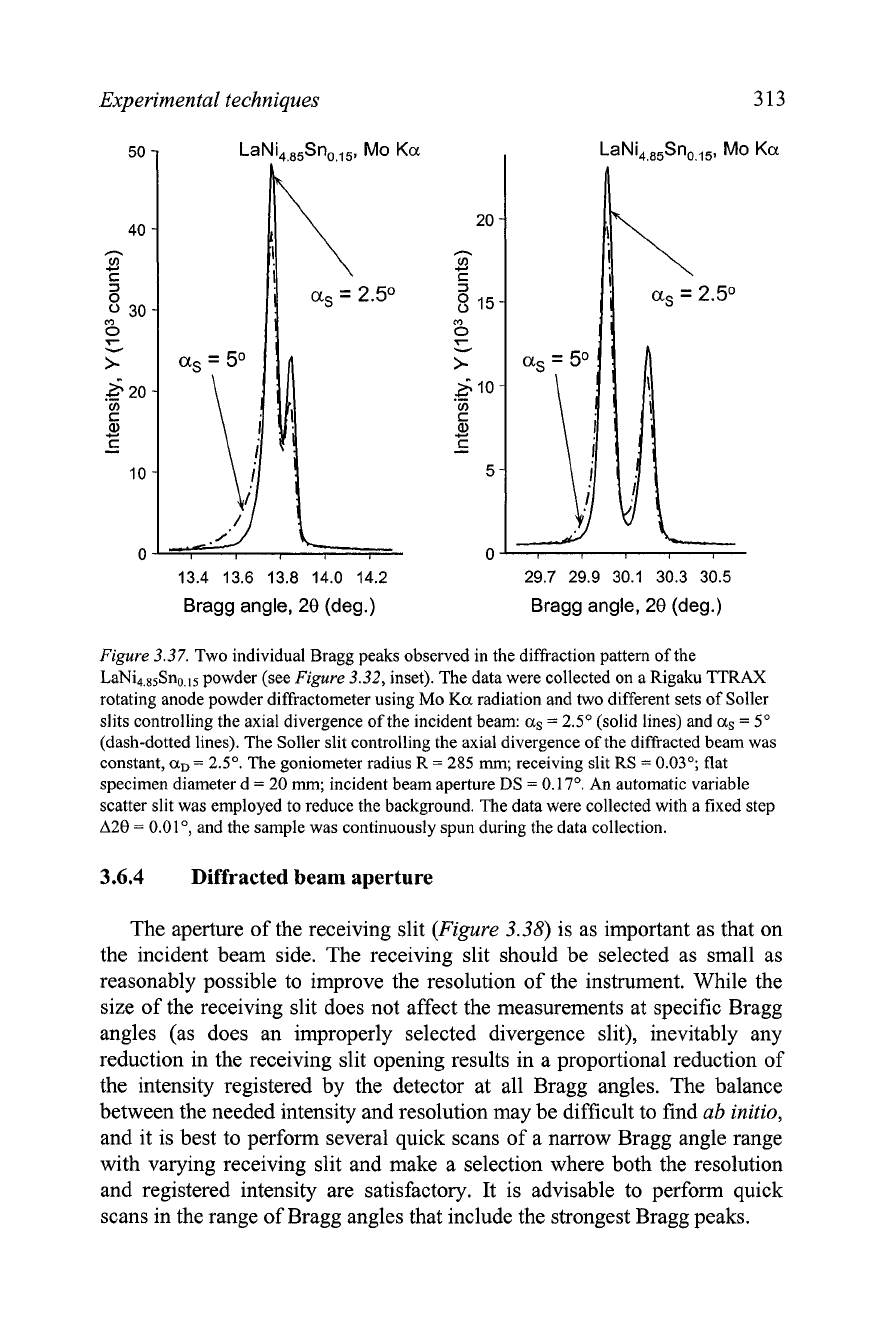
Experimental techniques
13.4 13.6 13.8 14.0 14.2
Bragg angle, 28 (deg.)
29.7 29.9 30.1 30.3 30.5
Bragg angle, 28 (deg.)
Figure
3.37.
Two individual Bragg peaks observed in the diffraction pattern of the
LaNi4,&,,, powder (see
Figure
3.32,
inset). The data were collected on a Rigaku
TTRAX
rotating anode powder diffractometer using Mo Ka radiation and two different sets of Soller
slits controlling the axial divergence of the incident beam:
as
=
2.5"
(solid lines) and
as
=
5"
(dash-dotted lines). The Soller slit controlling the axial divergence of the diffracted beam was
constant,
a~
=
2.5O.
The goniometer radius R
=
285 mm; receiving slit RS
=
0.03"; flat
specimen diameter d
=
20 mm; incident beam aperture DS
=
0.17". An automatic variable
scatter slit was employed to reduce the background. The data were collected with a fixed step
A20
=
0.01
",
and the sample was continuously spun during the data collection.
3.6.4
Diffracted beam aperture
The aperture of the receiving slit (Figure 3.38) is as important as that on
the incident beam side. The receiving slit should be selected as small as
reasonably possible to improve the resolution of the instrument. While the
size of the receiving slit does not affect the measurements at specific Bragg
angles (as does an improperly selected divergence slit), inevitably any
reduction in the receiving slit opening results in a proportional reduction of
the intensity registered by the detector at all Bragg angles. The balance
between the needed intensity and resolution may be difficult to find ab initio,
and it is best to perform several quick scans of a narrow Bragg angle range
with varying receiving slit and make a selection where both the resolution
and registered intensity are satisfactory. It is advisable to perform quick
scans in the range of Bragg angles that include the strongest Bragg peaks.
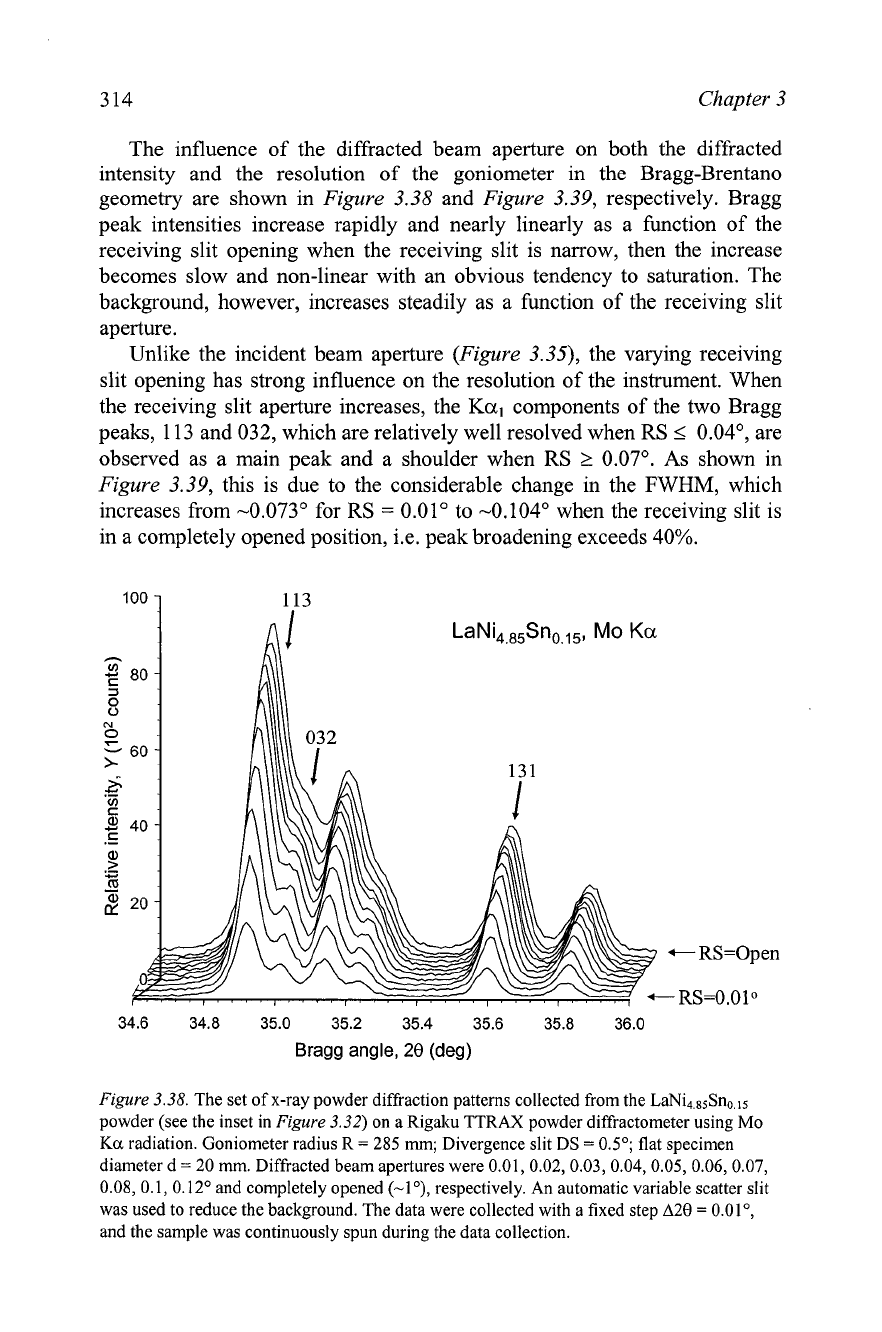
3 14
Chapter
3
The influence of the diffracted beam aperture on both the diffracted
intensity and the resolution of the goniometer in the Bragg-Brentano
geometry are shown in
Figure
3.38 and
Figure
3.39, respectively. Bragg
peak intensities increase rapidly and nearly linearly as a function of the
receiving slit opening when the receiving slit is narrow, then the increase
becomes slow and non-linear with an obvious tendency to saturation. The
background, however, increases steadily as a function of the receiving slit
aperture.
Unlike the incident beam aperture
(Figure
3.39, the varying receiving
slit opening has strong influence on the resolution of the instrument. When
the receiving slit aperture increases, the
Ka,
components of the two Bragg
peaks, 113 and 032, which are relatively well resolved when RS
I
0.04", are
observed as a main peak and a shoulder when RS
2
0.07". As shown in
Figure
3.39, this is due to the considerable change in the FWHM, which
increases from -0.073" for RS
=
0.01" to -0.104" when the receiving slit is
in a completely opened position, i.e. peak broadening exceeds 40%.
34.6 34.8 35.0 35.2 35.4 35.6 35.8 36.0
Bragg angle,
28
(deg)
Figure
3.38. The set of x-ray powder diffraction patterns collected from the LaNi,,85Sno,,5
powder (see the inset in
Figure
3.32)
on a Rigaku TTRAX powder diffractometer using Mo
Ka
radiation. Goniometer radius
R
=
285
mm;
Divergence slit DS
=
0.5'; flat specimen
diameter d
=
20
rnm.
Diffracted beam apertures were 0.01,0.02,0.03, 0.04,0.05, 0.06, 0.07,
0.08, 0.1, 0.12' and completely opened (-1
"),
respectively. An automatic variable scatter slit
was used to reduce the background. The data were collected with a fixed step A28
=
O.OlO,
and the sample was continuously spun during the data collection.
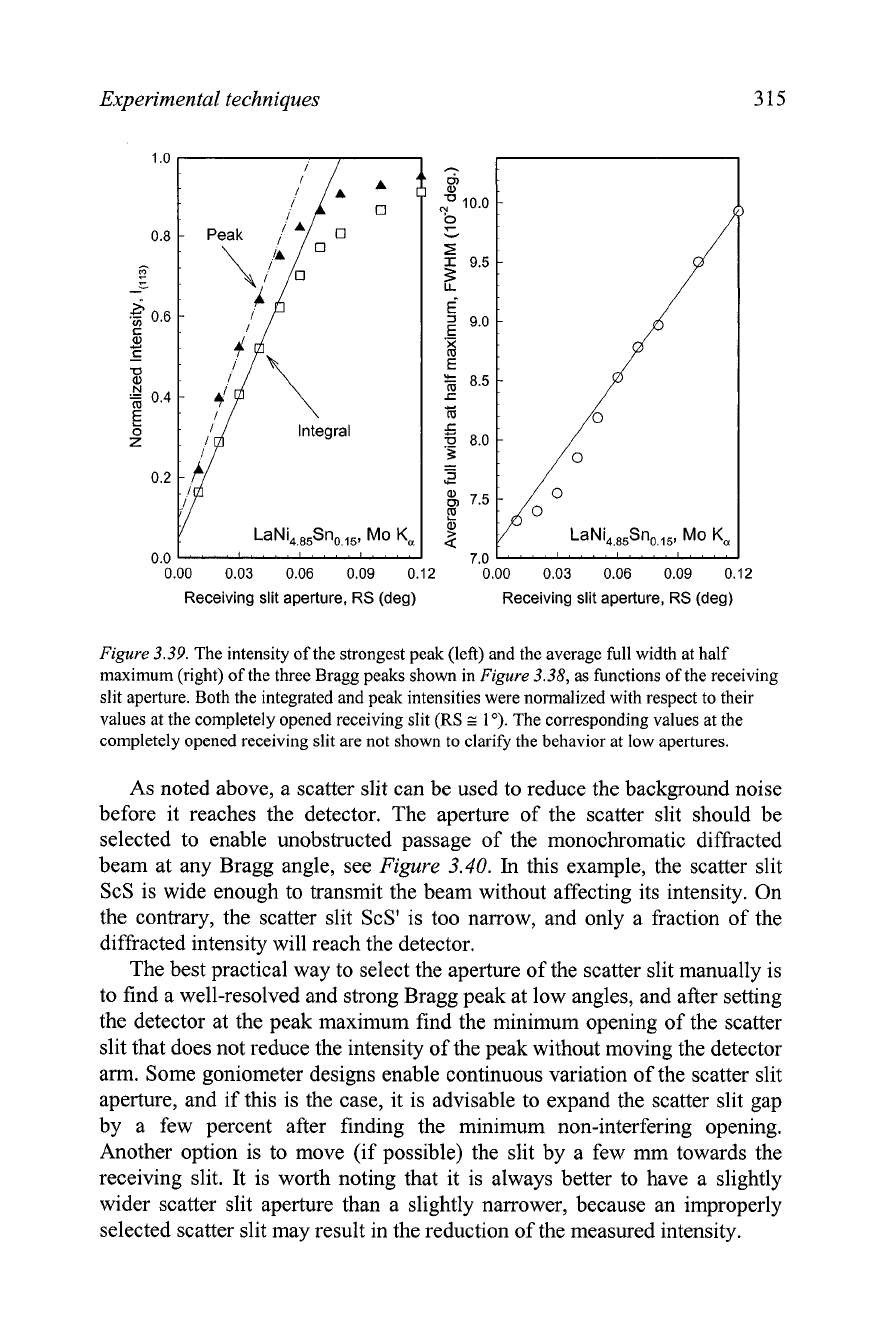
Experimental techniques
1
Integral
1
Receiving slit aperture,
RS
(deg)
Receiving slit aperture,
RS
(deg)
Figure
3.39.
The intensity of the strongest peak (left) and the average full width at half
maximum (right) of the three Bragg peaks shown in Figure
3.38,
as functions of the receiving
slit aperture. Both the integrated and peak intensities were normalized with respect to their
values at the completely opened receiving slit
(RS
E
lo).
The corresponding values at the
completely opened receiving slit are not shown to clarify the behavior at low apertures.
As noted above, a scatter slit can be used to reduce the background noise
before it reaches the detector. The aperture of the scatter slit should be
selected to enable unobstructed passage of the monochromatic diffracted
beam at any Bragg angle, see
Figure
3.40.
In
this example, the scatter slit
ScS is wide enough to transmit the beam without affecting its intensity. On
the contrary, the scatter slit ScS' is too narrow, and only a fraction of the
diffracted intensity will reach the detector.
The best practical way to select the aperture of the scatter slit manually is
to find a well-resolved and strong Bragg peak at low angles, and after setting
the detector at the peak maximum find the minimum opening of the scatter
slit that does not reduce the intensity of the peak without moving the detector
arm. Some goniometer designs enable continuous variation of the scatter slit
aperture, and if this is the case, it is advisable to expand the scatter slit gap
by a few percent after finding the minimum non-interfering opening.
Another option is to move (if possible) the slit by a few mm towards the
receiving slit. It is worth noting that it is always better to have a slightly
wider scatter slit aperture than a slightly narrower, because an improperly
selected scatter slit may result in the reduction of the measured intensity.
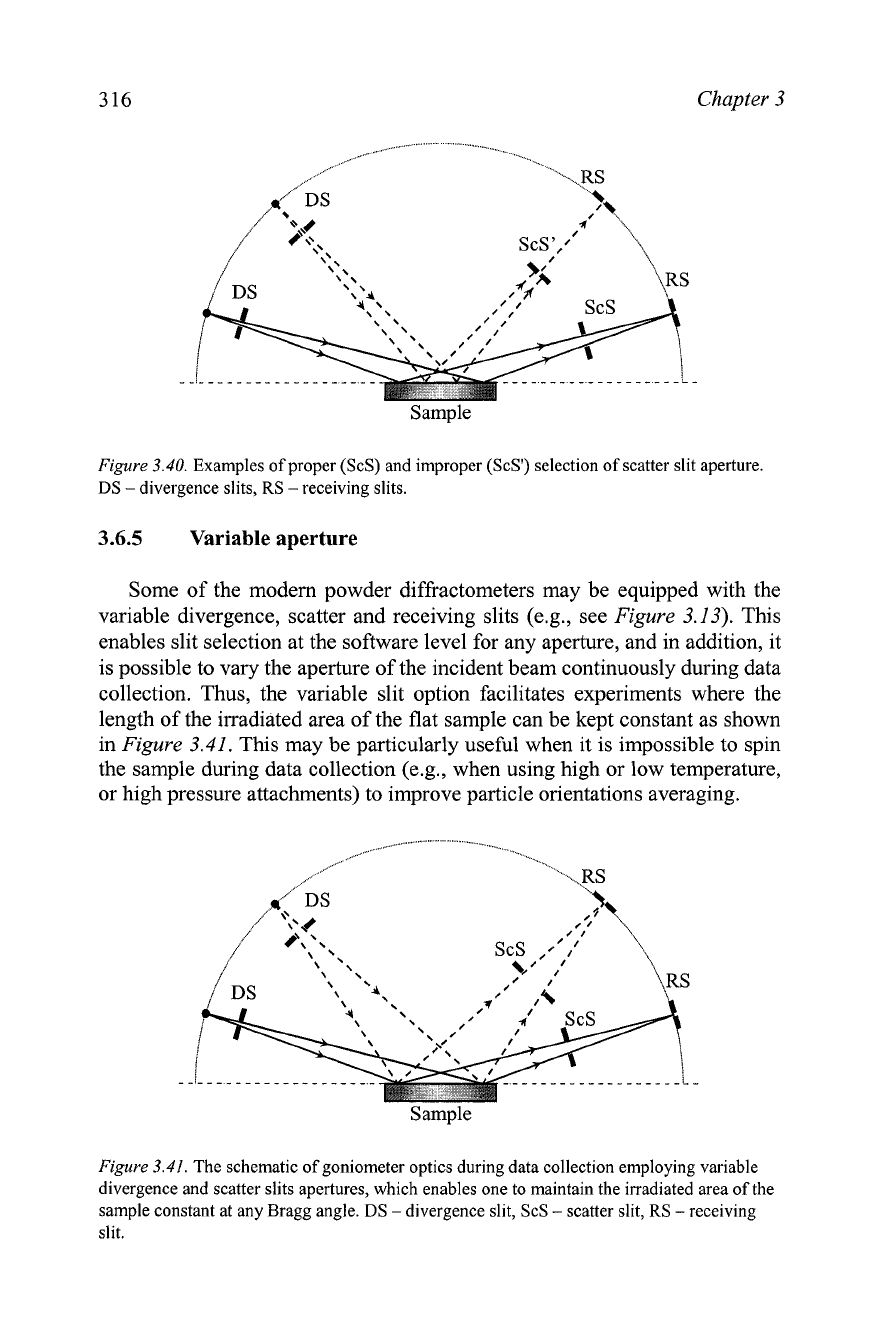
Chapter
3
Sample
Figure
3.40.
Examples of proper (ScS) and improper (ScS') selection of scatter slit aperture.
DS
-
divergence slits, RS
-
receiving slits.
3.6.5
Variable aperture
Some of the modem powder diffractometers may be equipped with the
variable divergence, scatter and receiving slits (e.g., see
Figure
3.13). This
enables slit selection at the software level for any aperture, and in addition, it
is possible to vary the aperture of the incident beam continuously during data
collection. Thus, the variable slit option facilitates experiments where the
length of the irradiated area of the flat sample can be kept constant as shown
in
Figure
3.41.
This may be particularly useful when it is impossible to spin
the sample during data collection (e.g., when using high or low temperature,
or high pressure attachments) to improve particle orientations averaging.
Figure
3.41.
The schematic of goniometer optics during data collection employing variable
divergence and scatter slits apertures, which enables one to maintain the irradiated area of the
sample constant at any Bragg angle. DS
-
divergence slit, ScS
-
scatter slit, RS
-
receiving
slit.
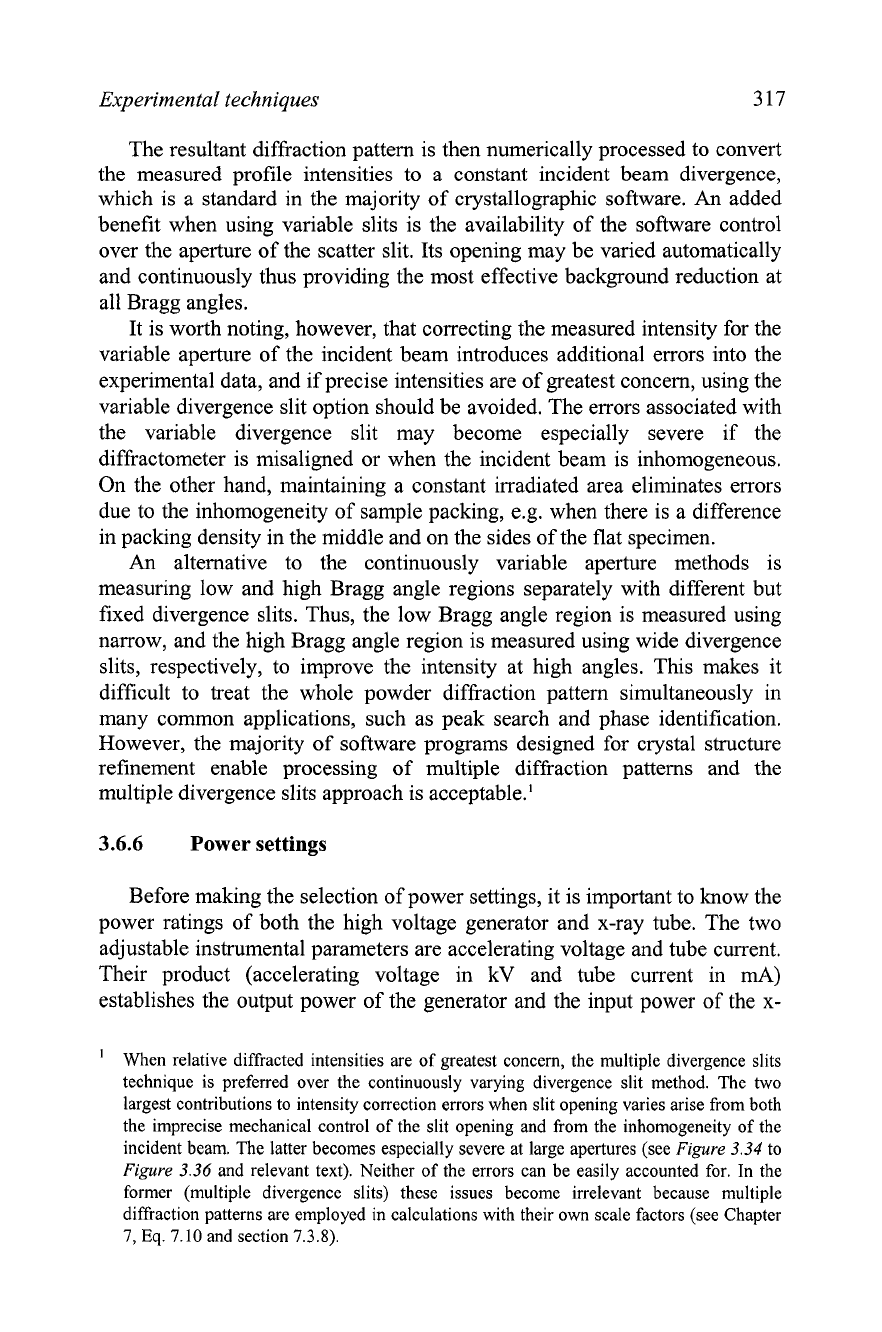
Experimental techniques
3
17
The resultant diffraction pattern is then numerically processed to convert
the measured profile intensities to a constant incident beam divergence,
which is a standard in the majority of crystallographic software.
An
added
benefit when using variable slits is the availability of the software control
over the aperture of the scatter slit. Its opening may be varied automatically
and continuously thus providing the most effective background reduction at
all Bragg angles.
It is worth noting, however, that correcting the measured intensity for the
variable aperture of the incident beam introduces additional errors into the
experimental data, and if precise intensities are of greatest concern, using the
variable divergence slit option should be avoided. The errors associated with
the variable divergence slit may become especially severe if the
diffractometer is misaligned or when the incident beam is inhomogeneous.
On the other hand, maintaining a constant irradiated area eliminates errors
due to the inhomogeneity of sample packing,
e.g. when there is a difference
in packing density in the middle and on the sides of the flat specimen.
An
alternative to the continuously variable aperture methods is
measuring low and high Bragg angle regions separately with different but
fixed divergence slits. Thus, the low Bragg angle region is measured using
narrow, and the high Bragg angle region is measured using wide divergence
slits, respectively, to improve the intensity at high angles. This makes it
difficult to treat the whole powder diffraction pattern simultaneously in
many common applications, such as peak search and phase identification.
However, the majority of software programs designed for crystal structure
refinement enable processing of multiple diffraction patterns and the
multiple divergence slits approach is acceptable.'
3.6.6
Power
settings
Before making the selection of power settings, it is important to know the
power ratings of both the high voltage generator and x-ray tube. The two
adjustable instrumental parameters are accelerating voltage and tube current.
Their product (accelerating voltage in
kV and tube current in
mA)
establishes the output power of the generator and the input power of the
x-
'
When relative diffracted intensities are of greatest concern, the multiple divergence slits
technique is preferred over the continuously varying divergence slit method. The two
largest contributions to intensity correction errors when slit opening varies arise from both
the imprecise mechanical control of the slit opening and from the inhomogeneity of the
incident beam. The latter becomes especially severe at large apertures (see
Figure
3.34
to
Figure
3.36
and relevant text). Neither of the errors can be easily accounted for. In the
former (multiple divergence slits) these
issues become irrelevant because multiple
diffraction patterns are employed in calculations with their own scale factors (see Chapter
7,
Eq.
7.10 and section 7.3.8).
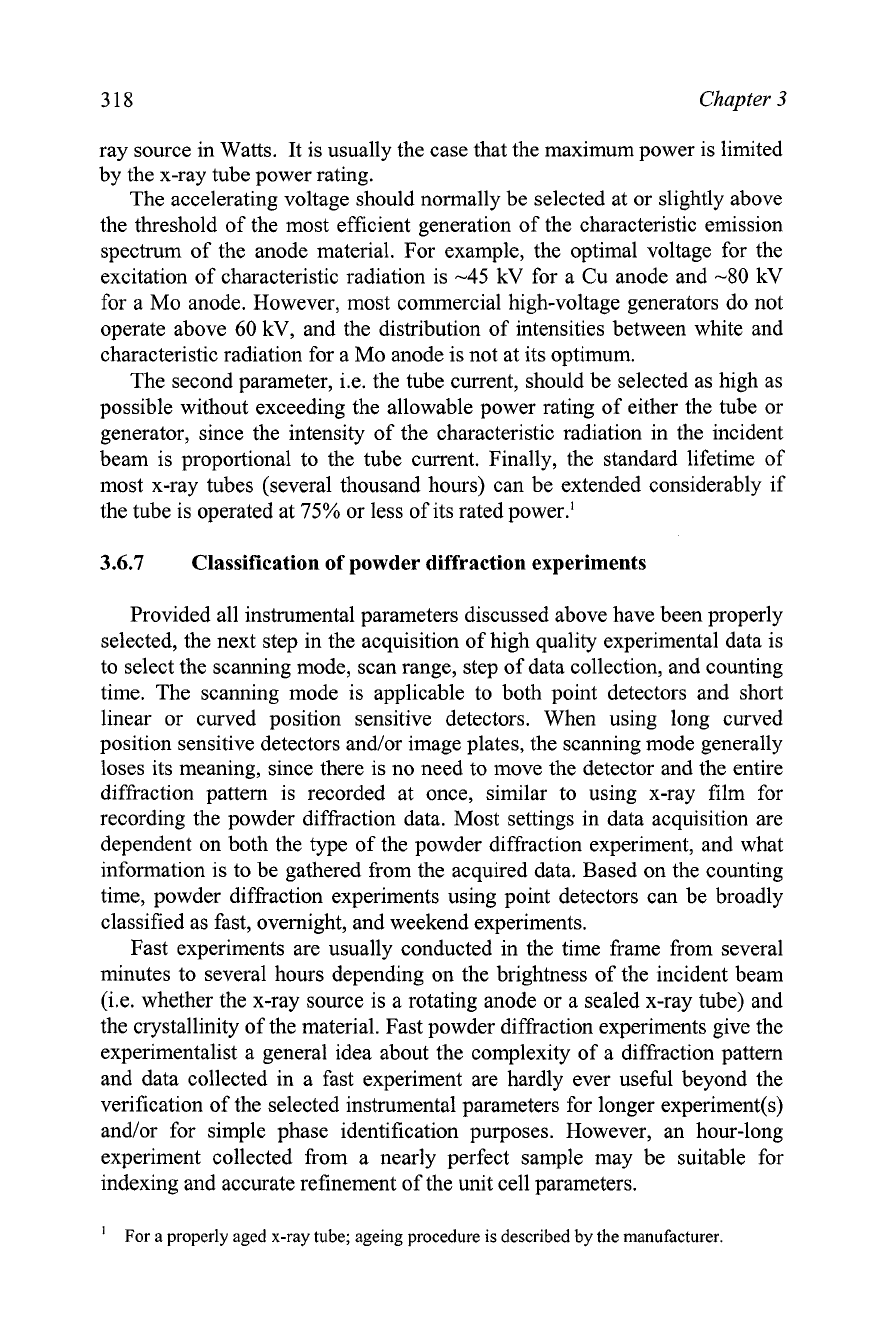
Chapter
3
ray source in Watts. It is usually the case that the maximum power is limited
by the x-ray tube power rating.
The accelerating voltage should normally be selected at or slightly above
the threshold of the most efficient generation of the characteristic emission
spectrum of the anode material. For example, the optimal voltage for the
excitation of characteristic radiation is
-45
kV for a Cu anode and
-80
kV
for a Mo anode. However, most commercial high-voltage generators do not
operate above
60
kV, and the distribution of intensities between white and
characteristic radiation for a Mo anode is not at its optimum.
The second parameter, i.e. the tube current, should be selected as high as
possible without exceeding the allowable power rating of either the tube or
generator, since the intensity of the characteristic radiation in the incident
beam is proportional to the tube current. Finally, the standard lifetime of
most x-ray tubes (several thousand hours) can be extended considerably if
the tube is operated at
75%
or less of its rated power.'
3.6.7 Classification of powder diffraction experiments
Provided all instrumental parameters discussed above have been properly
selected, the next step in the acquisition of high quality experimental data is
to select the scanning mode, scan range, step of data collection, and counting
time. The scanning mode is applicable to both point detectors and short
linear or curved position sensitive detectors. When using long curved
position sensitive detectors
andlor image plates, the scanning mode generally
loses its meaning, since there is no need to move the detector and the entire
diffraction pattern is recorded at once, similar to using x-ray film for
recording the powder diffraction data. Most settings in data acquisition are
dependent on both the type of the powder diffraction experiment, and what
information is to be gathered from the acquired data. Based on the counting
time, powder diffraction experiments using point detectors can be broadly
classified as fast, overnight, and weekend experiments.
Fast experiments are usually conducted in the time frame from several
minutes to several hours depending on the brightness of the incident beam
(i.e. whether the x-ray source is a rotating anode or a sealed x-ray tube) and
the crystallinity of the material. Fast powder diffraction experiments give the
experimentalist a general idea about the complexity of a diffraction pattern
and data collected in a fast experiment are hardly ever useful beyond the
verification of the selected instrumental parameters for longer experiment@)
andlor for simple phase identification purposes. However, an hour-long
experiment collected from a nearly perfect sample may be suitable for
indexing and accurate refinement of the unit cell parameters.
'
For a properly aged x-ray tube; ageing procedure is described by the manufacturer.
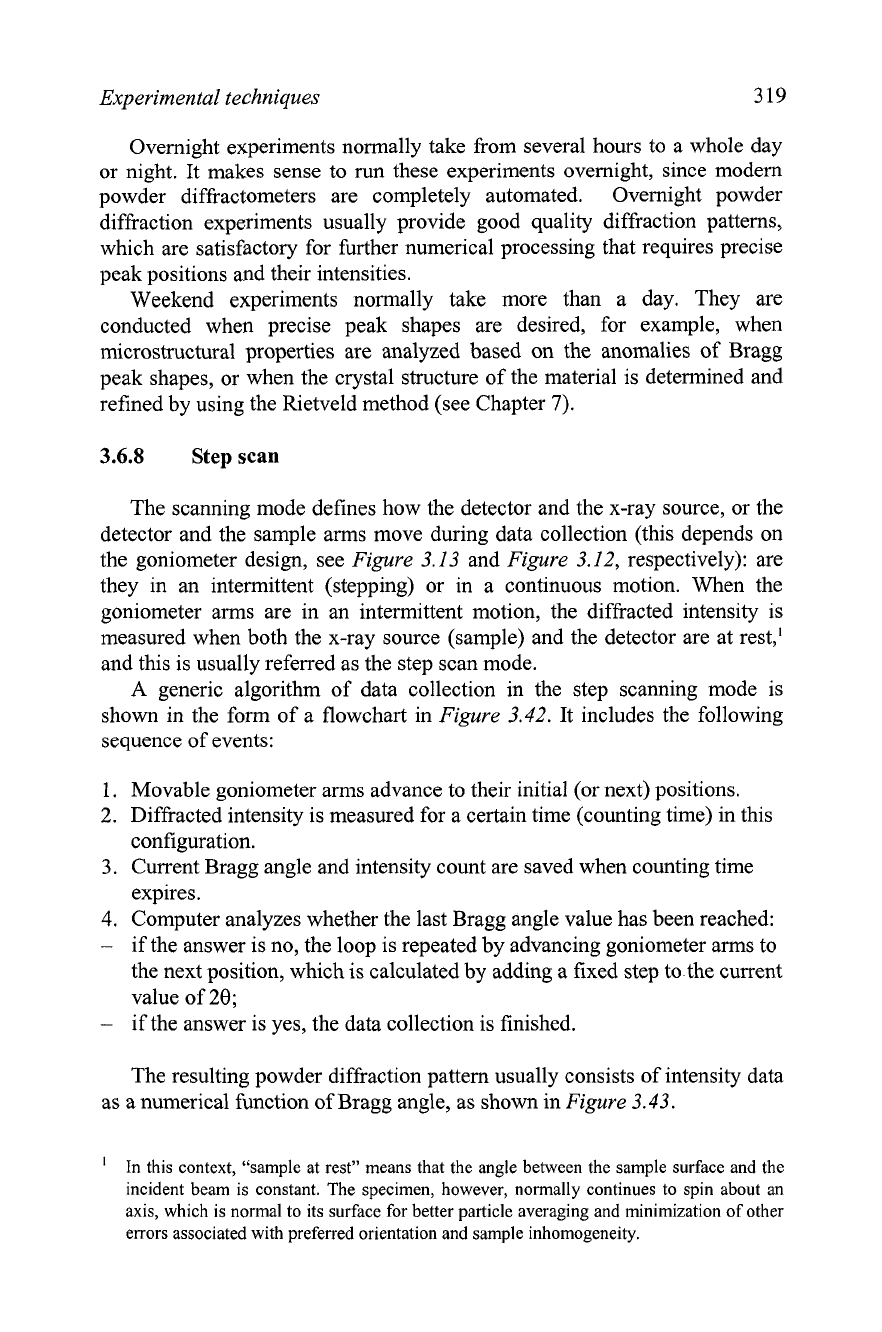
Experimental techniques
319
Overnight experiments normally take from several hours to a whole day
or night. It makes sense to run these experiments overnight, since modern
powder diffractometers are completely automated.
Overnight powder
diffraction experiments usually provide good quality diffraction patterns,
which are satisfactory for further numerical processing that requires precise
peak positions and their intensities.
Weekend experiments normally take more than a day. They are
conducted when precise peak shapes are desired, for example, when
microstructural properties are analyzed based on the anomalies of Bragg
peak shapes, or when the crystal structure of the material is determined and
refined by using the Rietveld method (see Chapter
7).
3.6.8 Step
scan
The scanning mode defines how the detector and the x-ray source, or the
detector and the sample arms move during data collection (this depends on
the goniometer design, see
Figure
3.13
and
Figure
3.12, respectively): are
they in an intermittent (stepping) or in a continuous motion. When the
goniometer arms are in an intermittent motion, the diffracted intensity is
measured when both the x-ray source (sample) and the detector are at rest,'
and this is usually referred as the step scan mode.
A generic algorithm of data collection in the step scanning mode is
shown in the form of a flowchart in
Figure
3.42. It includes the following
sequence of events:
1.
Movable goniometer arms advance to their initial (or next) positions.
2.
Diffracted intensity is measured for a certain time (counting time) in this
configuration.
3.
Current Bragg angle and intensity count are saved when counting time
expires.
4.
Computer analyzes whether the last Bragg angle value has been reached:
-
if the answer is no, the loop is repeated by advancing goniometer arms to
the next position, which is calculated by adding a fixed step to the current
value of
28;
-
if the answer is yes, the data collection is finished.
The resulting powder diffraction pattern usually consists of intensity data
as
a numerical function of Bragg angle, as shown in
Figure
3.43.
In this context, "sample at rest" means that the angle between the sample surface and the
incident beam is constant. The specimen, however, normally continues to spin about an
axis, which is normal to its surface for better particle averaging and minimization of other
errors associated with preferred orientation and sample inhomogeneity.

320
Chapter
3
Figure
3.42.
The flow chart visualizing a generic step scan data acquisition algorithm. The
main loop is highlighted by using thick arrows.
Advance goniometer arms
Measure intensity for
Start
to the initial or next position
*
a specified time
V
The two most important parameters of the step scan experiment, defined
by the user, are the size of the step in terms of Bragg angle, A28, and
counting time,
t.
The step size is constant throughout the entire experiment,
and it is usually selected between 0.01 and 0.05" of 28. Using Cu
Ka
radiation, the value A28
=
0.02' is quite standard. When using Mo
Ka
radiation, step size should be generally reduced to A20
=
0.01". High energy
synchrotron radiation may require steps as low as 0.001". Neutron powder
diffraction data are usually collected with 0.05 to
0.1' 28 steps.
When Bragg peaks are extremely broad, and when conducting fast
experiments, larger step sizes for analytical x-ray diffractometers are
acceptable. On the contrary, when the crystallinity of the examined material
is high and Bragg peaks are narrow, lower step sizes should be employed.
A
rule of thumb for the selection of the step size is that at least
8
to 12 data
points should be measured for well-resolved peaks within one full width at
half maximum. Even lower A28 values are used when precise Bragg peak
shape data are needed for structure refinement and microstructure
determination. When selecting A28 it is important to remember that small
step sizes improve resolution, which obviously cannot exceed the limits
imposed by the goniometer optics, while large step sizes reduce the duration
of the experiment.
Yes
Stop
Instrument specific header
Bragg angle 1, Number of accumulated counts 1[, Error 11
Bragg angle 2, Number of accumulated counts 2
[,
Error 21
Bragg angle
3,
Number of accumulated counts
3
[,
Error
31
...,
...
[,
...
I
Bragg angle N, Number of accumulated counts N[, Error N]
-------
Save
28
and current
photon count
Figure
3.43.
Example of powder diffraction data file format. Optional experimental errors
in
the measured intensity are shown in square brackets.
